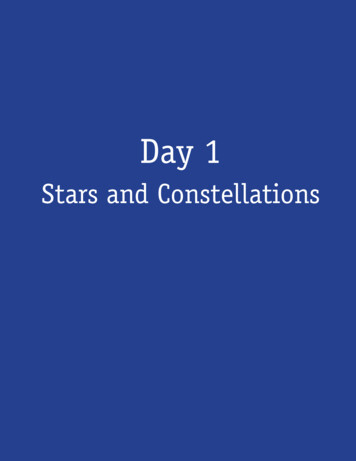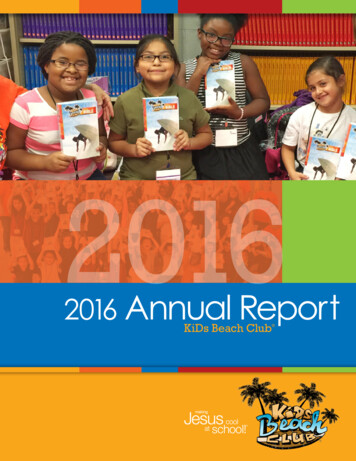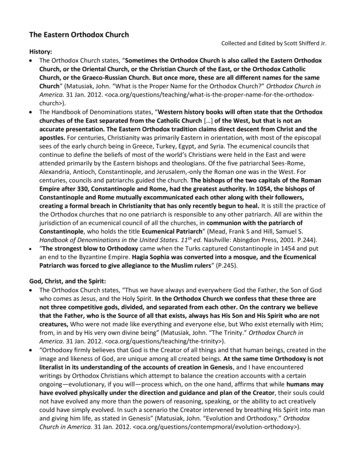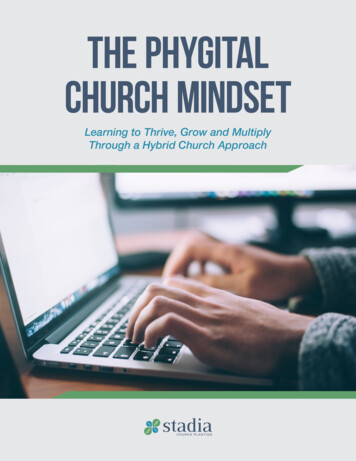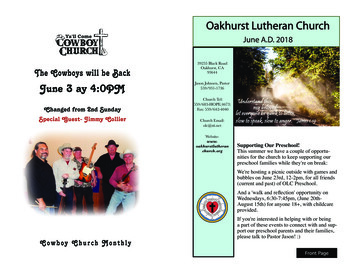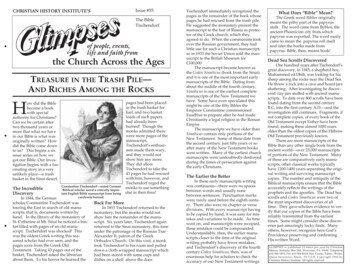
Transcription
Issue #55CHRISTIAN HISTORY INSTITUTE’SThe BibleTischendorfof people, events,life and faith from the Church Across the AgesTREASURE IN THE TRASH PILE—AND RICHES AMONG THE ROCKSH ow did the Biblebecome a bookwith specialauthority for Christians?Can we be certain aftertwo thousand years ormore that what we havein our Bible is what wasoriginally written? Howdid the Bible come downto us? This begins a sixissue series on how wegot our Bible. Our investigation begins with a fascinating story in a veryunlikely place—a trashbasket in the Sinai desert.The IncredibleDiscovery Constantine Tischendorf—noted GermanBiblical scholar saved a critically important English Bible manuscript from beingcarelessly burned.In 1844, the Germanscholar Constantine Tischendorf wastouring the East in search of old manuscripts, that is, documents written byhand. In the library of the monastery ofSt. Catherine at Mt. Sinai he noticed a basket filled with pages of an old manuscript. Tischendorf was shocked! Thiswas the oldest Greek writing this seasoned scholar had ever seen, and thepages were from the Greek OldTestament. Taking 43 pages out of thebasket, Tischendorf asked the librarianabout them. To his horror he learned thepages had been placedin the trash basket forfuel, and two basketloads of such papershad already beenburned! Though themonks admitted therewere more pages of themanuscript,Tischendorf’s enthusiasm made them wary,and they would notshow him any more.They did allowTischendorf to take the43 pages he had rescuedwith him, however, andTischendorf urged themonks to use somethingelse in their fires!Back For MoreIn 1853 Tischendorf returned to themonastery, but the monks would notshow him the remainder of the manuscript. Six years later, Tischendorf againreturned to the Sinai monastery, this timeunder the patronage of the Russian TsarAlexander II, patron of the GreekOrthodox Church. On this visit, a monktook Tischendorf to his room and pulleddown a cloth-wrapped manuscript whichhad been stored with some cups anddishes on a shelf above the door.Tischendorf immediately recognized thepages as the remainder of the book whosepages he had rescued from the trash pile.He suggested the monastery present themanuscript to the tsar of Russia as protector of the Greek church, which theyagreed to do. When the communists tookover the Russian government, they hadlittle use for such a Christian manuscript,so in 1933 the Soviet Union sold the manuscript to the British Museum for 100,000.The manuscript became known asthe Codex Sinaiticus (book from the Sinai),and it is one of the most important earlymanuscripts of the Bible. Dating fromabout the middle of the fourth century,Sinaiticus is one of the earliest completemanuscripts of the New Testament wehave. Some have even speculated thismight be one of the fifty Bibles theEmperor Constantine commissionedEusebius to prepare after he had madeChristianity a legal religion in the RomanEmpire.The manuscripts we have older thanSinaiticus contain only portions of theNew Testament. Some of these date fromthe second century, just fifty years or soafter many of the New Testament bookswere written. Many of the earliest churchmanuscripts were undoubtedly destroyedduring the times of persecution againstthe early Christians.The Earlier the BetterIn these early manuscripts writingwas continuous—there were no spacesbetween words and usually nonebetween sentences. Punctuation markswere rarely used before the eighth century. There also were no chapter or versedivisions. With every manuscript havingto be copied by hand, it was easy for mistakes and variations to be made. As timewent on, and manuscripts were recopied,these mistakes could be compounded.Understandably, then, the earlier manuscripts closer to the time of the originalwriting probably have fewer mistakes,and Tischendorf’s discovery of the fourthcentury Codex Sinaiticus, then, was ofenormous help for scholars to check theaccuracy of our New Testament writings.What Does “Bible” Mean?The Greek word Biblios originallymeant the pithy part of the papyrusstalk. The word came from Byblos, theancient Phoenician city from whichpapyrus was exported. The word easilycame to mean the papyrus roll itselfand later the books made frompapyrus. Bible, then, means book!Dead Sea Scrolls DiscoveredOne hundred years after Tischendorf’sgreat discovery, in 1945, a shepherd boy,Muhammed ed Dhib, was looking for hissheep among the rocks near the Dead Sea.He threw a rock into a cave and heard jarsshattering. After investigating he discovered clay jars stuffed with ancient manuscripts. To date over 800 scrolls have beenfound dating from the second centuryB.C. into the first century A.D.—and theinvestigation still continues. Fragments, ifnot complete copies, of every book of theOld Testament except Esther have beenfound, making these almost 1000 yearsolder than the oldest copies of the HebrewOld Testament previously known.There are more manuscripts of theBible than any other single book from theancient world—over 25,000 manuscriptsof portions of the New Testament. Manyof these are comparatively early manuscripts; other classical works typicallyhave 1200-1400 years separating the original writing and surviving manuscriptcopies. The number and antiquity of theBiblical manuscripts ensure that the Bibleaccurately reflects the writings of theprophets and the apostles. The Dead Seascrolls and Codex Sinaiticus were two ofthe most important discoveries of alltime. They gave scholars evidence to verify that our copies of the Bible have beenreliably transmitted from the earliesttimes. Some might consider these discoveries just amazingly lucky finds. Manyothers, however, recognize here God’sProvidence preserving and confirmingHis written Word.GLIMPSES is published 12 times per year by ChristianHistory Institute, Box 540, Worcester, PA 19490. Telephone610-584-1893, Fax 610-584-4610. Ken Curtis, Editor. Writer,Diana Severance, Klein, TX I.S.D. Copyright 1994 byChristian History Institute. All rights reserved.
CHRISTIAN HISTORY INSTITUTE’SIssue #56The BibleThe Canonof people, events,life and faith from the Church Across the AgesTHE AMAZING SELECTION, PRESERVATION ANDRECOGNITION OF THE BOOKS OF THE BIBLEfrom the Latin cannont’s mind-boggling!—used in warfare!)The Bible is not onemeant a rule, measurbook, but a librarying rod, or standard.of 66 books writtenBy the fourth centuryover a 1500-year perithe Christians concluod in 3 languages bysively recognized that40 authors living in 10there was a Christiandifferent countries.canon—the collectedThe authors’ workswritings which setinclude history, mysforth the standards oftery, romance, poetry,Christian truth as firstprose, and eventaught by the apostles.humor! A cast of 2,930In part, this finalizacharacters are depictedtion of the Christianin 1,551 places. Howcanon came aboutdid this amazing collecbecause of the rise oftion ever come about?various heresies.God revealedHimself through HisInternal ThreatHebrew prophets.THE BIBLE SURVIVED DESPITEThe Gnostic hereticThe Jews reverencedVIOLENT OPPOSITION.Marcion, about 140the writings of thePictured here: Roman Emperor Diocletianfrom bust found in Nikomedia (Izmit),A.D., was the first toprophets and carefulTurkey. He instituted the “Great Persecution”make a list of whatly preserved them.and demanded that every copy of the Bible beThese sacred writings destroyed. He reportedly had the words extinc- books he thought wereto domine Christianosum (“the name of thedepositories of thebecame the ScripturesChristians having been destroyed”) put overtruth. Marcionof the first Christians.ashes of a copy of the Bible. He spoke toobelieved the God ofChristians recognizedsoon. His horrendous persecution could notdestroy the church or the Bible.the Old Testament wasthese Scriptures conevil, so he rejected thetained promises ofentire Old Testament! He only acceptedthe coming of Jesus.parts of the gospel of Luke and ten ofInspired writings from the earliest churchPaul’s epistles as true. Surprisingly thiswere later added to the Hebrew sacredfalse teacher was performing a valuablebooks to make up a canon of Scripture.service. By listing the books he thoughtThe Greek word canon (quite differentI were evil and wrong, the church leaderserence to all the writings of the Newwere forced to carefully consider and conTestament being brought into one book.firm what Christian writings were truePrevious to this, the various writings ofand authoritative.the New Testament were in separateIrenaeus, a church father writingscrolls or smaller collections of writings.about 180 A.D., and only two generationsfrom the apostle John, attacked Marcion’sA Sorting Out ProcessGnostic heresies. Irenaeus affirmed theThere were many other ChristianHebrew Scriptures, the Old Testament, aswritings in circulation in the fourth century.true because in them were the manySome were good reading but obviouslyprophecies fulfilled in Jesus Christ. Henot inspired; others claimed to bealso used quotations of many of the Newinspired but were actually written byTestament writings to show the error ofheretics and false teachers. BishopMarcion’s teachings about the person andAthanasius of Alexandria in Egypt wassalvation work of Jesus Christ.concerned about the influence theseThroughout the second and thirdheretical writings were having on his peocenturies the church fathers constantlyple—some believers were even preparingquoted the earlyastrological chartsFinal Confirmationapostles and theshowing the starsTwo North African church councils,gospels to explainnamed after theat Hippo Regius in 393 and at CarthageChristian teaching tosaints! A number ofin 397, also accepted the 27 books listedbelievers and tothe false books,by Athanasius as comprising the Newwage war againstsuch as the GospelTestament canon. However, neitherheretics. Theseof Thomas, hadEusebius, nor Athanasius, nor theScriptures were anames similar tochurch councils established the canoncanon or rule to bothScripture but wereof Scripture. As New Testament scholmeasure truth andfull of error.ar, F.F. Bruce explained: The Newresist error; and theAthanasius realizedTestament books did not become authoritaearly church was inthat the besttive for the church because they were forstrong agreement asdefense againstmally included in a canonical literature; onto which writingsheresy was a clearthe contrary, the church included them inwere sacred.understanding ofher canon because she already regardedScripture. In hisScriptures Burned them as divinely inspired.Easter letter of 367,In 303 theAthanasius setRoman Emperor Diocletian sponsored thebefore his people “the books included inlast empire-wide persecution of thethe Canon and handed down, and accredChristians. His edicts demanded thatited as Divine.” Athanasius’ list of thechurches be destroyed and the scripturesnames of the inspired books of both theburned. Some Christians themselvesOld and New Testaments was the first listwere burned because they refused to turnof Biblical books which corresponds toover their sacred books.the books we have in our Bibles today. InSoon after the Emperor Constantinewriting about them, Athanasius said,proclaimed Christianity a legal religion inThese are the fountains of salvation, that they324 A.D., he requested that Eusebius ofwho thirst may be satisfied with the livingCaesarea produce 50 copies of thewords they contain Let no man add toScriptures for use in the capital city ofthese, neither let him take ought from these.Constantinople. Of the many Christianwritings available, Eusebius was to collectonly the sacred ones and combine themGLIMPSES is published 12 times per year by Christianinto one volume (Some believe CodexHistory Institute, Box 540, Worcester, PA 19490. Telephone610-584-1893, Fax 610-584-4610. Ken Curtis, Editor. Writer,Sinaiticus mentioned in issue #55 wasDiana Severance, Klein, TX I.S.D. Copyright 1994 byamong these copies). This is the first refChristian History Institute. All rights reserved.
CHRISTIAN HISTORY INSTITUTE’SIssue #57The BibleJeromeof people, events,life and faith from the Church Across the AgesTHE FEISTY JEROME: HIS BIBLELEGACY LASTED OVER 1,000 YEARSO ne of the most pivotal figures inthe history of the preservationand transmission of the Bible wasa brilliant, temperamental, dedicated,irascible scholar name Jerome. He wasborn in 331 A.D. in northeast Italy andbecame the most learned man of the 4thcentury Latin-speaking church.A Disturbing Dream His parents were well-to-do Christianswho sent Jerome to Rome to be educatedwhen he was about ten. In Rome, Jeromebecame an accomplished classical scholarwith an insatiable passion for learning.After completing his schooling, Jerometraveled throughout the Roman empire,from Gaul (France) to Palestine. He studied Christian theology in Trier, Germanyand became part of an ascetic communityin Aquilea, Italy. Jerome moved on toAntioch where he had a dream whichstrongly convicted him—Christ wasscourging him and accusing him, “Youare a Ciceronian, and not a Christian.”Jerome felt he had devoted too much ofhis life to studying the pagan classics atthe expense of Christian truth, and hevowed not to study pagan literature—avow he kept for ten years.From 374 to 377 Jerome lived as ahermit in the desert east of Antioch, fasting and studying. He found a JewishChristian nearby from whom he learnedHebrew, eventually mastering Hebrew asDetail from St. Jerome Readingby Giovanni Bellini (c. 1427-1516)Samuel H. Kress Collection, National Gallery of Art, WashingtonUsed by permission.no other Christian of his day had. Jeromealso had to battle with the desires of theflesh. When he dreamed of dancing girlsin Rome he simply fasted and studiedmore than before. Jerome stated his ownprinciple in studying was: to read theancients, to study everything, to hold fast thegood, and never to depart from the Christianfaith.When he returned to Antioch fromthe desert, Jerome was ordained a presbyter. However, Jerome never ministeredin a church, preferring the monastic life.Jerome returned to Rome when hewas about fifty and became the theologi-cal advisor and Secretary to PopeDamasus. In Rome he began his greatservice to the church of Christ—translating the Bible into common Latin. Jerome’sknowledge of languages and his travelsthroughout the west and east made himperfectly equipped for this gigantic task.Reliable Latin Version NeededLatin was the common language ofthe western Roman Empire, and therewere already many Latin versions of theScriptures in circulation. These, however,varied greatly in accuracy and readability. Pope Damasus wanted Jerome torevise the translation of the Gospels andthe Psalms. In revising the Psalms, inRome, Jerome used the Septuagint text.The Septuagint was the Greek translationof the Hebrew Old Testament which hadbeen made in Alexandria, Egypt.The legend was that seventy-twotranslators worked in individual cells,and when they came together to comparetheir work, their translations were exactlythe same! Many thought that theSeptuagint (or LXX for the 70 elders) wasdivinely inspired. The apostles oftenquoted from the Septuagint translations.Early Latin translations of the OldTestament, including Jerome’s work inRome, were all from the Septuagint.While in Rome Jerome also lashedout against the immorality and corruption of the imperial city. He protestedthat the clerics and the monks wereworldly and self-seeking; the language heused towards them was often harsh andvenomous. When Pope Damasus died in384, Jerome went to Bethlehem, accompanied by some loyal followers, includingseveral wealthy Roman ladies who hadtaken vows of chastity.Love the ScripturesIn Bethlehem Jerome and a wealthywoman named Paulina established twomonastic communities, one for men andanother for women. Paulina also established a hospice for pilgrims, since Josephand Mary had not found lodging in thetown! Away from the politics and turmoil of Roman life, Jerome could live theascetic, monastic life he so desired anddevote himself to study. For the next fif-teen years Jerome went behind the GreekSeptuagint and translated the books ofthe Old Testament Bible from the Hebrewinto Latin. These translations of individual books were often done for his friends.Jerome was often criticized for using theHebrew text rather than the Septuagint asthe basis for his translation, but he rightlyargued that the Septuagint was notinspired and that a better translationcould be made from the Hebrew, the original language of the Old Testament.Jerome believed that the knowledge ofthe Scripture was the riches of Christ;ignorance of the Scripture was ignoranceof Christ. He repeatedly exhorted othersto saturate their minds with theScriptures: Make knowledge of the Scriptureyour love and you will not love the views ofthe flesh.I beg you, dear brother, live withthem, meditate on them, make them the soleobject of your knowledge and inquiries. Hiswork was accompanied by the prayer thathis Latin translation might speak thetruth of God as clearly and powerfully asthe original Hebrew or Greek.He Did “More Than Anyone Will”Jerome’s Latin translation steadilyincreased in importance in the following centuries. He had stood at the twilight of the ancient world and had prepared the Scriptures which would beused throughout the dawning MiddleAges. Latin was the universal languageof Europe during these years, andJerome’s translation of the Scripturesinto the common tongue became theVulgate (or common) Bible. For tencenturies the phrases of the Vulgateshaped the liturgy of the church as wellas Europe’s theology, literature, andlaw. When Wycliffe translated theBible into English and Luther translated it into German, they translated fromJerome’s Latin Vulgate. Though MartinLuther disliked Jerome’s monasticideals, he had to admit that St. Jeromehas personally done more and greater intranslation than any man will imitate.GLIMPSES is published 12 times per year by ChristianHistory Institute, Box 540, Worcester, PA 19490. Telephone610-584-1893, Fax 610-584-4610. Ken Curtis, Editor. Writer,Diana Severance, Klein, TX I.S.D. Copyright 1994 byChristian History Institute. All rights reserved.
CHRISTIAN HISTORY INSTITUTE’SIssue #58The BibleThe Middle Agesof people, events,life and faith from the Church Across the AgesTHE LIGHT OF THE WORLDINTO THE DARK AGESwho previously had nohe Christianwritten language.Gospel from theThe earliest items writtime of Jesus wasten in any Germanic lanmeant for the wholeguage are the fragmentsworld. But as thewe have of the BibleGospel spread there wastranslated by Ulfilas inthe need to present it inthe fourth century.the many different lanUlfilas’ grandparents hadguages of the people. Inbeen Christians inthe third centuryCappadocia (in modernArmenia became theTurkey) when thefirst officially ChristianGermanic Goths raidednation. Mesrop, bishopthe region and carriedof Armenia (390-439),them off as captives.created an ArmenianMany of those capturedalphabet so the Bibleby the Goths werecould be translated intoChristians, and it wasthe language of his peothrough their witnessple. An Armenian slavePRE-REFORMATION PIONEERthat Christianity firstwoman brought theA Statue of Peter Waldo, in Worms,Germany. He founded the Waldensianspread among thegospel message toin the late 12th century, com- Germanic tribes. UlfilasGeorgia in Russia, which movementmissioned translations of books of the(whose name means “litsoon also had the Bible in Bible into his local French-Provencaltle wolf”) received a goodlanguage and urged Bible reading byits own language.the common people.education inAs ChristianityConstantinople, where hespread to the borders ofpossibly was a hostage. Since he spokethe Roman empire, translations wereGreek and Latin as well as Gothic, hemade into the languages of the barbarianbecame an able missionary to the barbartribes. Often the translator would firstian tribes. Ulfilas organized the Gothichave to develop an alphabet for peoplechurch and was its spiritual head for fortywho did not have a written language,years. At this time the Goths had no writmuch as translators do today amongten language, so Ulfilas devised an alpharemote tribes. Throughout historybet so he could begin to translate theChristianity has repeatedly encouragedBible for them.the development of literacy among peopleT Missionary Monks Cyril & MethodiusPerhaps the most famous alphabetdeveloped by Christian missionaries wasthe Cyrillic alphabet, developed by twobrothers who were missionaries to theSlavic people in the ninth century. Cyriland Methodius were born in Thessalonica.The brothers became monks and weresent by the Emperor in Constantinople toMoravia. The liturgy of the church in theeast was Greek. But Cyril believed that allpeople should learn to praise God in theirown language—that was the only waythey could understand and practiceChristianity properly. The Slavs did nothave an alphabet, so Cyril invented analphabet especially for them. He mostlyused Greek letters, but he also used someArmenian and Hebrew letters, as well assome letters he made up for particularSlavic sounds. The Cyrillic alphabet isstill used in Russia, Bulgaria, Serbia, andamong other Slavic peoples. When Cyrildied in 869, Methodius continued as amissionary in Moravia. He translated theentire Bible into the Slavic language beforehis death in 885. Cyril and Methodiuscontinue to be highly revered among theSlavic peoples today, not only for bringingChristianity to the people, but for creatingthe literary language of the Slavs.In western Europe, during the MiddleAges, Latin was the official language of thechurch, and the Bible was most oftenfound in Jerome’s Latin Vulgate.Sometimes translations into the commonlanguage of the people were writtenbetween the lines of Latin Bibles. Thesewere usually to help the missionaries andpriests explain the Scriptures to the peoplein their language. Even the educated,however, rarely saw an entire Bible. Bibleswere very rare, large, expensive, and usually in 2-3 volumes. Sometimes thewealthy would have translations of thePsalms or the Gospels. During the crusades the books of Kings, with its history ofwarfare and fighting, became popular, andcrusaders sometimes had personal copiesof these sections of the Old Testament.Bible Stories in Many FormsIn the medieval church the Scriptureswere shared in many imaginative waysChapter and VerseChapter and versedivisions are not partof the original Biblemanuscripts. Threedifferent people arecredited with addingchapter divisions tothe Latin Vulgate:Lanfrancthe Archbishop ofCanterbury, Lanfranc (d. 1089), anotherArchbishop of Canterbury, StephenLangton (d. 1228), and Hugo de SanctoCaro of the 13th century. Verse numbers to the Greek New Testament wereadded in 1551 by Robert Etienne and tothe Old Testament a few years later.for much of the population could not readand books were not readily available. TheBible was interpreted through mysteryplays performed at festivals or the carvings and stained glass windows of cathedrals or in church music and great art.Waldo and Wycliffe Begin ReformsA group of Christians in twelfth century France founded by Peter Waldo andcalled the Waldensians were among thefirst to demand Bible study by the common people. Their ideas spread intoFlanders and Germany, and at least portions of the Scriptures were again translated into the language of the people.Under the guidance of Oxford scholarJohn Wycliffe, an English translation ofthe Bible was made in the fourteenth century. Wycliffe believed the Word of Godshould be open to all people. The churchauthorities were afraid the Bible in thehands of the uneducated would only produce heretical departures from officialchurch doctrine. Having translations ofthe Scripture was often banned by thechurch, and many were punished for having a Bible in their own language. Thesewere dark days! As the Hebrew prophetsaid, there had come a “famine for hearing the words of the Lord” (Amos 8:11).GLIMPSES is published 12 times per year by ChristianHistory Institute, Box 540, Worcester, PA 19490. Telephone610-584-1893, Fax 610-584-4610. Ken Curtis, Editor. Writer,Diana Severance, Klein, TX I.S.D. Copyright 1994 byChristian History Institute. All rights reserved.
CHRISTIAN HISTORY INSTITUTE’SIssue #59The BibleTyndaleof people, events,life and faith from the Church Across the AgesGOD’S OUTLAWAND FUGITIVE FOR BIBLICAL FAITH Roger Rees as William Tyndale at his trialFrom “God’s Outlaw,” courtesy of Gateway FilmsT he Bible continues to be the bestselling book in English year afteryear and we have literally dozens ofversions readily available to us. But didyou know that some Christians sufferedhorrible deaths to make it possible for usto have the Bible in the English language?“Lord, open the King of England’seyes”—many in the crowd heard WilliamTyndale’s loud and earnest prayer justbefore the authorities strangled him andburned him to ashes. As the flameslicked Tyndale’s broken body it seemedhis lifelong dream and dying prayerwould die with him. But, as we will see,both were amazingly fulfilled only twoyears after he died.William Tyndale was born near theWelsh border of England in 1494. Fortyyears earlier, two important eventsoccurred in Europe which would have agreat impact on Tyndale’s life and work.In May, 1453, the Turks had stormedConstantinople, and the capital of theEastern Roman Empire fell to the Mosleminvaders. Greek scholars fled westwardand brought with them a scholarshipwhich had been almost forgotten in theWest. Greek language studies of the classics increased, and the Scriptures began tobe studied in the original Greek, ratherthan the Latin Vulgate. The invention ofthe printing press in 1454 was a secondimportant development. The printingpress would eliminate copyist errors andmake the Scriptures more easily availablein quantity editions.But to have the Bible in English wasillegal. In an attempt to restrain the influence of Wycliffe’s followers, in 1408Parliament had passed the “Constitutionsof Oxford” which forbade anyone translating or reading a part of the Bible in thelanguage of the people without permissionof the ecclesiastical authorities. Men andwomen were even burned for teachingtheir children the Apostles’ Creed, theLord’s Prayer, and the Ten Commandmentsin English. William Tyndale, however,had an unquenchable passion to makethe Bible available to every Englishman.Even the Plowboy Should Have BibleOn Press, On the RunTyndale studied at the universities ofTyndale fled England to translate theOxford and Cambridge, could speakBible on the Continent. Even there heseven languages, and became skilled inhad to be careful to avoid English spiesHebrew and Greek. When theand informers, as well as European oppoRenaissance scholar Erasmus published anents of the Reformation. His whereGreek edition of the New Testament,abouts are often difficult to determine,Tyndale discovered the truths of justificabut he spent time in Hamburg,tion by faith and the priesthood of allWittenberg, Cologne, Worms, andbelievers. He realized that the EnglishAntwerp. In 1525 his New Testamentpeople were in darkness, following errorswas printed and smuggled back intoand superstition, because of their ignoEngland. It was the first translation of therance of the Scriptures. Tyndale foundBible from the original Greek intohis own purpose in life expressed inEnglish—indeed, it was the first translaErasmus’ preface to his New Testament:tion of a Greek book into English.Christ wishes his mysteries to be published asKing Henry VIII, Cardinal Wolsey,widely as possible. I would wish even alland Sir Thomas More were all furious atwomen to read the gospel and the epistles ofthis unlicensed translation. Thomas MoreSt. Paul, and I wish that they were translatedwrote a work attacking Tyndale’s translainto all languages of alltion as a mistranslaChristian people, andtion full of heresy.Tyndale’s Prayer Answeredthat they might be readTwo years after Tyndale was exeand known, not merely cuted, King Henry VIII of EnglandOpponentsby the Scotch and theordered that a copy of the Scriptures inFinance WorkIrish, but even by theEnglish be placed in every parishTyndale’sTurks and thechurch.work received anSaracens. TyndaleMore English translations followedamazing unintendexhorted that it wasTyndale’s. The King James Bibleed boost when bishin the language ofbecame the historic authorized versionops bought as manyIsrael that the Psalmsthat became the most influential bookcopies of his translawere sung in the temin the history of the English language.tion as possible tople of Jehovah; andWilliam Tyndale’s translation provideddestroy them. Theshall not the gospelover 90% of the wording of the Kingprice they paid prospeak the language ofJames version.vided Tyndale theEngland among us?.desperately neededOught the church to have less light at noonmoney to print even more improved andday than at dawn?. Christians must read thecorrected editions. The King’s wife, AnneNew Testament in their mother tongue.Boleyn, was an admirer of Tyndale (herTyndale determined to give the Englishcopy of Tyndale’s testament is now in thepeople a translation of the Bible that evenBritish Museum), but she was not able toa plowboy could understand.persuade the King to approve such translation of the Scripture. The King, Wolsey,Permission Deniedand More all had agents on the ContinentTyndale went to the Bishop ofhoping to find and arrest Tyndale. InLondon, Cuthbert Tunstall, to seek per1534 Tyndale was betrayed by a falsemission to translate the Bible into English.friend near Brussels, arrested by imperialTunstall refused. But while in Londonforces, and thrown into prison. He wasTyndale came into contact with severalaccused of maintaining that faith alonemerchants who were smuggling intojustifies. He was found guilty and in 1536England some of Martin Luther’s writingswas executed.from Germany. They encouragedGLIMPSES is published 12 t
Dead Sea Scrolls Discovered One hundred years after Tischendorf's great discovery, in 1945, a shepherd boy, Muhammed ed Dhib, was looking for his sheep among the rocks near the Dead Sea. He threw a rock into a cave and heard jars shattering. After investigating he discov-ered clay jars stuffed with ancient manu-scripts. To date over 800 .




